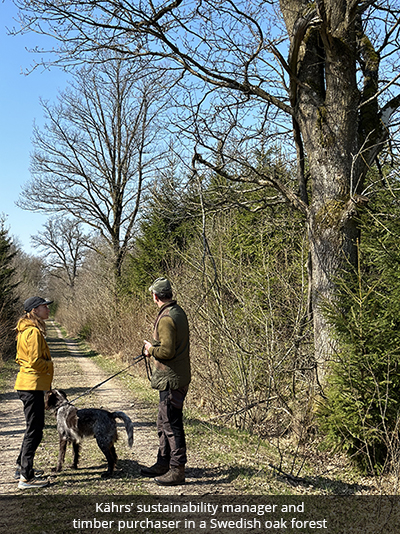Kährs has submitted science-based FLAG target
Biodiversity & Nature – why all companies need to take urgent action
Kährs has submitted science-based Forest, Land & Agriculture (FLAG) targets
To keep 1.5°C within reach, tackle food crisis risks and enable the transformation to a global net-zero future, cutting land related emissions is of high importance.
The world’s Forest, Land and Agriculture (FLAG) sector is one of the industries at highest risk from the impact o f climate change. But it is also a significant source of emissions. It represents nearly a quarter of global greenhouse gas (GHG) emissions - the largest emitting sector after energy, but it also has the potential to absorb a significant amount of existing emissions from the atmosphere. To address this gap in emission accounting and reduction, the Science Based Target initiative (SBTi) introduced new FLAG guidance in April 2023 that requires SBTi committed companies to account for their FLAG emissions and provide pathways for decarbonization in line with the 1.5 degrees Celsius scenario.
f climate change. But it is also a significant source of emissions. It represents nearly a quarter of global greenhouse gas (GHG) emissions - the largest emitting sector after energy, but it also has the potential to absorb a significant amount of existing emissions from the atmosphere. To address this gap in emission accounting and reduction, the Science Based Target initiative (SBTi) introduced new FLAG guidance in April 2023 that requires SBTi committed companies to account for their FLAG emissions and provide pathways for decarbonization in line with the 1.5 degrees Celsius scenario.
Kährs has now submitted (Forest, Land & Agriculture) FLAG targets together with near-term company-wide emission reductions in line with climate science with the SBTi. We are now awaiting validation of these targets.
“Many companies with land-intensive operations have committed or set targets through the SBTi. Many are also reporting their GHG emissions publicly. However, few account for land-based emissions or removals in their targets or disclosures. A key barrier has been the lack of available guidance and methods - until now.” (sciencebasedtargets.org)
GHG accounting criteria and recommendations on FLAG emissions have been historically poorly addressed and there has been no framework on target setting for these emissions. Only a few companies have been accounting for and reporting these emissions at some level. The reason for this is lack of data and methodology, resulting in around 22% of global emissions from the land sector not being accounted for appropriately in corporate carbon footprint calculations.
“The SBTi’s FLAG Guidance provides the world’s first standard method for companies in land-intensive sectors to set science-based targets that include land-based emission reductions and removals. The guidance enables companies to reduce the 22% of global greenhouse gas emissions from agriculture, forestry and other land use.” (sciencebasedtargets.org)
Biodiversity & nature related disclosure, strategy and transparency
– why all companies need to take urgent action
Most of the world's largest companies  are significantly dependent on nature in their operations even as the biodiversity and ecosystems underlaying those resources are declining due to overexploitation and climate change. Protecting nature is an absent priority for many companies, even though nature underpins much of the global economy. Over half of global GDP in 2019 — was moderately or highly dependent on natural assets and their ecosystem services.
are significantly dependent on nature in their operations even as the biodiversity and ecosystems underlaying those resources are declining due to overexploitation and climate change. Protecting nature is an absent priority for many companies, even though nature underpins much of the global economy. Over half of global GDP in 2019 — was moderately or highly dependent on natural assets and their ecosystem services.
The economy is reliant on the ecosystem services that nature provides in many ways. For example, ecosystem services provide wood for timber harvest; ground water or fresh water for drinking, cooling power plants or irrigation; and animal or plant fibers for fabrics or fertilizer.
The global economy is benefiting from nature even as it is driving nature loss, which is reducing nature’s ability to sustain those ecosystem services. Pollution, deforestation, and other unsustainable land use, paired with climate change and the spread of invasive species, have put about 1 million animal and plant species at risk of extinction, many within decades, according to the UN.
Healthy and diverse ecosystems also play a key role in absorbing carbon emissions and helping both the natural world and human society adapt to the physical impacts of climate change. But nature’s ability to provide those services will diminish with every degree of global warming, the Intergovernmental Panel on Climate Change (IPCC) warned in its recent synthesis report. We need to think beyond GDP, not estimating the full wealth of society and include natural capital into official economic statistics.
The United Nations Biodiversity Conference (COP15) ended in Montreal, Canada, on 19 December 2022 with a landmark agreement to guide global action on nature through to 2030. COP 15 resulted in the adoption of the Kunming-Montreal Global Biodiversity Framework (GBF). The GBF aims to address biodiversity loss, restore ecosystems, and protect indigenous rights. The plan includes concrete measures to halt and reverse nature loss, including putting 30 per cent of the planet and 30 per cent of degraded ecosystems under protection by 2030, called 30 by 30. It also contains proposals to increase finance for developing countries.
Many companies are in the initial stages of measuring and understanding the risks that nature poses to their businesses. The just finalized set of disclosure recommendations from TNFD could help companies answer some of these questions. The Taskforce on Nature-related Financial Disclosures is crafting a voluntary framework that companies can use to assess nature related risks and opportunities, released sept 2023.
So, what can businesses do today?
- Assess your impacts and dependencies on nature
- Commit to set Science Based targets and set your direction of where you want to travel,
- Change the way you behave, transform your operations into a nature positive direction.
- Then decide to show your insights to people and organizations around you and tell them what you have learned and what you are going to do. It is all about disclosure.
To sum it all up
There is an urgency for companies to start disclosing how they are working with nature and biodiversity related matters, but there is little guidance on how to do this. In September TNFD released their voluntary framework that can help companies understand what and how to disclose. Science Based Targets recently released their science-based targets for land, forest, and agriculture in line with 1.5 degrees Paris agreement, which is a good step on the way towards defining, disclose, quantify, and work towards set targets.
